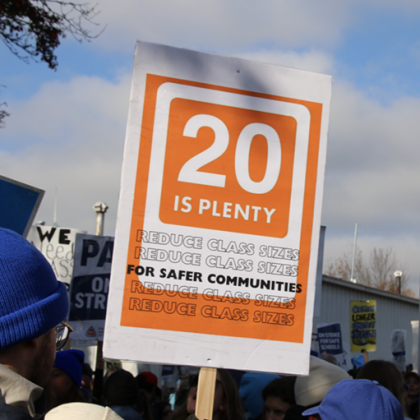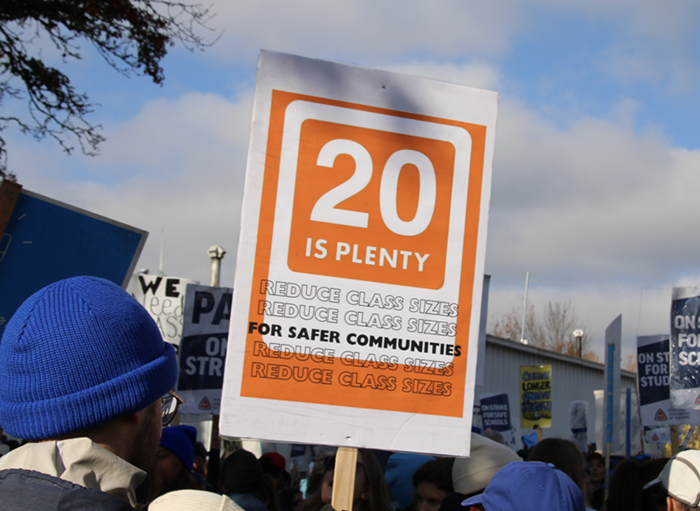Feature your business, services, products, events & news. Submit Website.
Breaking Top Featured Content:
Disagreement About Class Size Decisions Fueling Teachers’ Strike Stalemate

by Taylor Griggs
Portland Public Schools (PPS) teachers and district management have been negotiating a new contract for the better part of a year, with educators proposing substantial cost-of-living-adjustments, mental health support reform, and more. But as the PPS teachers’ strike nears the three-week mark, it appears the final sticking point in contract negotiations is about whether or not parents should be involved in decisions about class size.
A proposal from the union advocates for creating “class size committees” in lieu of strict class size caps, which had previously been a large component of the union’s bargaining platform. The committees would be formed on an as-needed basis at schools that struggle with large class sizes.
Many Portlanders hoped district management and the Portland Association of Teachers (PAT) union would reach an agreement last weekend and end the strike that’s been going on since November 1. For much of the month, the union and district haven’t appeared to make significant progress. But recent bargaining dispatches have been more optimistic of the strike, giving hope that students and educators will return to the classroom after Thanksgiving break.
Some of that optimism dissipated Monday morning after PAT claimed the PPS board backed out of a tentative contract agreement between the union and district management.
“After 24 hours at the bargaining table, the PPS board rejected the recommended settlement from its own bargaining team that would have students and educators returning into schools as soon as possible,” PAT stated in an email to union members. “This crisis of their own making unnecessarily prolongs the strike, and demonstrates the inability of district leadership to govern Oregon’s largest school district.”
It became clear later in the morning that the main issue preventing a contract agreement was about how to limit class sizes. Teachers say class sizes should be determined by committees that include parents, rather than formulas the district currently uses. PPS says that would jeopardize student privacy by revealing information about special accommodations and individual education plans. PPS officials also have a different story about what played out at the bargaining table last weekend.
“This is the core obstacle to arriving at a conceptual agreement.”
After the union released an update, social media lit up with frustrated responses from the public, including a call to oust PPS board members in the next election. But board members and district management soon responded with a different version of the story.
PPS Communications Director Will Howell told the Mercury the district and union did not have a tentative agreement, which is a specific term referring to a contract proposal that has been agreed to by union and management bargaining team members and is waiting to be voted on by the union rank-and-file.
“We have tentatively agreed to 17 articles since Thursday, so we’ve been cooking along,” Howell said. “But there was no tentative agreement last night.”
Howell also said the three board members present at the bargaining table— board chair Gary Hollands, Julia Brim-Edwards, and Herman Greene— have been meeting with the rest of the district’s bargaining team to provide their feedback. This weekend, the three board members voiced their qualms with one of the articles in the contract, but did not meet as a board to authorize a final verdict on the agreement.
At a Monday morning district press conference, held after an overnight session at the bargaining table, bleary-eyed PPS board members said the key issue at hand is regarding “parents having the ability to make educated decisions about other people’s children.”
“There were many things in the proposal that we could agree on, [but] there were also some fundamental issues…that we could not agree on,” Hollands said. “This is what needs to be worked out and we are expecting to work through those concerns today in order to get our kids back to school on November 27…I want to be explicitly clear that this is the core obstacle to arriving at a conceptual agreement.”
Hollands was referring to the proposal for class-size committees. The committees would consist of school personnel, including the principal and a teacher, as well as two parents appointed by the school’s Parent Teacher Association, and would convene to “develop a plan on what to do about each potential class…with a class size issue.”
District officials and board members said the committee members would have access to private information about children in order to decide what to do in situations where class sizes are exceeding a certain threshold. Board members said they were uncomfortable with giving parents in the group information about individual children pertaining to their learning or mental health needs.
“If you had a child who was on an Individual Education Program or had a mental health issue…other parents might have access to that information [under this proposal],” Brim-Edwards said at the Monday press conference. “Speaking as a parent, there are things about my children that are very private to our family. I think most parents feel that and would not feel comfortable with that information…spreading across the parent community.”
Brim-Edwards said the board thinks there’s a role for parents “in the broader, school-level decision-making around class sizes,” but not on an individual level.
Perspectives from parents and teachers

A PAT member advocates for smaller class sizes at a rally earlier this month. Taylor griggs
The union’s proposal does not explicitly advocate for committee members to have access to individual students’ information, and suggests potential solutions to excessive class sizes could include “additional reading interventionists or additional push in support.” The proposal states the parents on the committee will be jointly approved by the principal and the PAT building representative, and that a “lack of parent involvement will not preclude the committee from developing recommendations.”
On Monday afternoon, a coalition of PPS parents and grandparents held a rally at the Multnomah County Building to demonstrate their support for teachers and the class size committee proposal. The sit-in, which garnered hundreds of teachers and parentsThe group sent Brim-Edwards a letter prior to the sit-in, explaining their position.
“As a member of the PPS board, and someone serving on the negotiating team during this important strike, we urge you to not only support our teachers, but to recognize the important role parents and grandparents play in educating our children and supporting our schools,” the letter states. “We support the creation of class size committees made up of parents, teachers, and administrators who would have a voice and a vote in determining appropriate class size. We look forward to a future where the voice and participation of parents and grandparents can work in partnership with teachers and administrators to ensure an excellent education for our children.”
One parent who signed the letter, Christopher Zimmerly-Beck, has a child at Duniway Elementary School. According to a recent Oregonian analysis, 31.3 percent of classes at Duniway were above the district and union’s agreed-upon threshold (24 students in kindergarten, 26 in grades one through three, and 28 in grades four and five). Prior to the sit-in, Zimmerly-Beck told the Mercury he thinks parent voices are important in order to ensure PPS addresses class sizes.
“There have been real problems getting PPS administration to enforce policies they already have around class size,” Zimmerly-Beck said. “We want families involved in the education of their children. I think you can definitely talk about class size without violating children’s rights to privacy. It seems pretty preposterous to me that would be the excuse they would hide behind.”
Zimmerly-Beck said he hasn’t seen PPS management or the board propose another solution for reducing class sizes.
“They’re not offering anything except for saying, ‘We don’t want parents involved,’ he said. “I think allowing parents to be involved in a problem-solving process has got to be better than just treating the classroom as a sardine can and shoving kids into it.”
After a much-needed nap break, the district and union bargaining teams are set to return to the negotiating table.
“I think we’re hoping to pass them back a compromise, because we recognize there is a desire for parents to have a voice in conversations about class size,” Howell said. “We’re hoping to strike a middle ground.”
Continue Reading at PortlandMercury.com here
